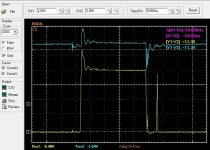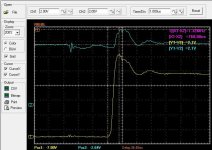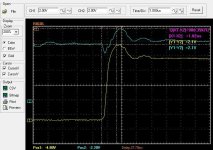WORK IN PROGRESS
I put the update for 10/16/10 in blue, so folks who read what I had yesterday won't have to re-read.
Why do are controllers have caps?
To protect the FETs, and to improve controller efficiency and performance.
How do caps protect the FETs? What do my FETs need protection from?
Your motor is a big inductor. To operate this motor, current is switched through these coils of the motor. Everytime the FETs switch from ON to OFF, the inductor trys to maintain this current level it was previously seeing (and the energy they use to do this is energy stored in building the magnetic field and the associated delay in the rate current climbs when initially switched "ON", so energy in/out is balanced). It can't maintain current by holding the same voltage, so as this field in the inductor colapses, the voltage skyrockets trying to maintain that current flow through the now greatly increased resistance of the FETs in the OFF state.
This effect is called flyback, freewheeling, or a number of other names to define this inherent voltage spike.
This flyback voltage spike occurs on absolutely every conductor that suddenly becomes an open circuit. If it's a giant coil of wire around a stator tooth, or a 2cm trace on a PCB, it has inductance, and when it switches from carrying current to not carrying current, it will have a spike. The magnitude and energy in this spike depends on the inductance of the path this current is/was flowing through.
To make an metaphor for help folks visualize this effect, think of the inductance in the system like a bungee-cord. As you the FETs switch ON at the start of a cycle, it tugs that bungee cord to a given stretch distance, and as the PWM cycles, it's moving back and forth, but the displacement of the stretch in the bungee cord dampens this effect, and keeps the tension of what you're tugging against roughly flat. Now, when the FET opens, it's like somebody just snips the connection, and the cord "fly's back" in way where that tension (current) gets very quickly converted into high velocity (voltage), and the things on both ends of this lead had better be ready to absorb this extremely rapid conversion from nice smooth tension into snapping that energy stored from stretching that bungee (energy stored in creating the magnetic field).
if anyone wants to make a better example, please do, I will replace mine with it. I am not a poet.






